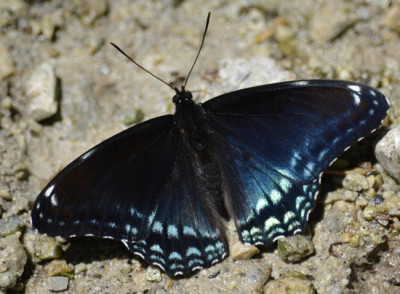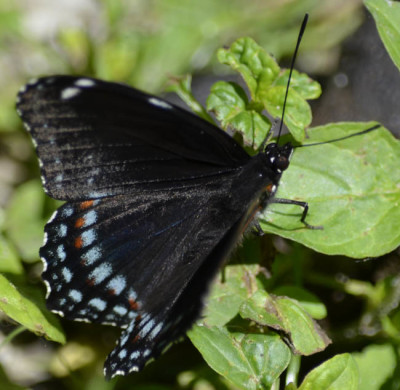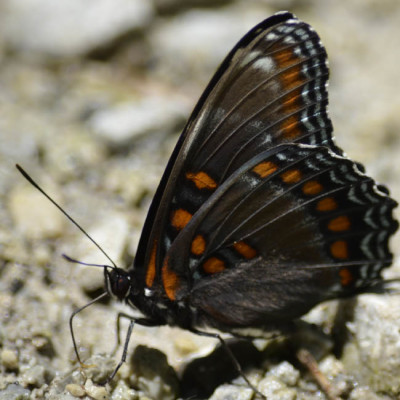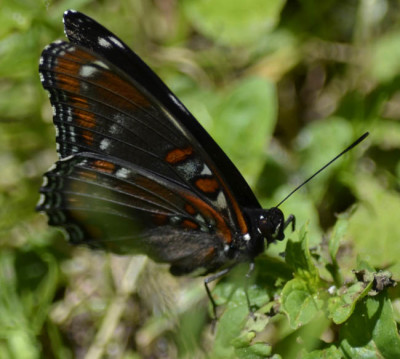While rambling through the Riverwood Conservancy in mid-June I encountered a lovely black and blue butterfly. Smaller than a Monarch but larger than a Cabbage White it danced around in tight circles, never rising more than 2 metres (6 feet) off the ground then landed on the finely graveled path. What kind of butterfly was it?
A Tale of Two Black and Blue Butterflies
A bit further along the ramble, I met another very similar butterfly. They were not identical, though. One had some red dots on the wings, the other did not. I’m glad I got photos of both because it reassures me when looking up the type of butterfly to know they come both spotted and unspotted. Further checking around on the internet also proved this to be true.
This is the Red Spotted version of the White Admirals I met.
Introducing the Red-Spotted Purple Butterfly
I’m not too sure how useful this name is. The red spots, as my two butterflies show, seem to be optional, at least from the top view.
A quick glimpse of this butterfly might make you think it’s black.
They also are black and if the sun hits them from the proper angle iridescent blue. I’m not sure where the “purple” is supposed to be!
Still, that’s the name given to these rather startling attractive butterflies.
Also Known as White Admiral Butterflies!
The real surprise to me was that these fancily coloured butterflies were an old familiar favourite dressed in gaudy new colours. These butterflies are White Admirals. They can breed together and produce viable young together and near the line where the two variations in colouring meet there are many intermediate combinations of colours.
Side view of this colour variation of a White Admiral butterfly.
What Were These Butterflies Doing in the woods of the Riverwood Conservancy?
The second butterfly I encountered was rather daintily checking out the damp pebbles and mud on the footpath along the Credit River. I quite enjoyed taking its photos.
Here’s a nice clean photo of the side view, the way butterflies including this one, usually perch.
The first, I am a bit squeamish about saying, was engaged in feeding on or gathering moisture from shall we say the leavings of the digestive system of a large dog. (Who said cleaning up after your pet is necessarily better for the environment? This butterfly wouldn’t agree!)
According to BugGuide.net the butterflies may be gathering moisture from the damp ground and, er, the other source.
What Do White Admiral Caterpillars Eat
According to Butterflies and Moths of North America, the caterpillars feed on tree leaves including cherry, cottonwood, birch, basswood, aspen, willow and oak. They certainly should find something to their liking at Riverwood ! It does mean I am unlikely to meet one of the caterpillars at eye level while it feeds.
Even if I don’t, I look forward to my next glimpse of the butterfly form of these wonderful White Admirals.
Related Reading
Join In
Have you seen White Admirals in their dressy blue outfits? Or are the regular white-striped butterflies more common in your neck of the woods? Please share your experiences with a comment.






Just had one of these beauties in my garden on my butterfly bush.
I live in southern Ontario near Chatham. We get a lovely variety here :)
They are quite a showy butterfly, aren’t they? I’m sure they appreciate your flowers. Thanks for sharing!
We found a dead white admiral this summer. Saved it to show the family.
When I was a child, back when the dinosaurs roamed, many people used to collect butterflies. That’s discouraged now but there’s nothing wrong with collecting ones that have already died. They let children get a really clear look and they can even see what people mean about the ‘scales’ coming off the wings if they are handled.
Thanks for sharing your experience!
I just this weekend saw a beautiful Black and Blue with a small dab of red butterfly in the PA APPALACHIAN Mountains. What a beauty! I had to look it up on line to see what is was! At first I thought it was a Black Monarc but look just like the Red Spotted Purple butterfly posted above. Awesome
They are a gorgeous butterfly–thanks for sharing your sighting!
We found numerous Tussock Moth Caterpillars on milkweed in our garden today, along with Monarch Butterfly Caterpillars. I want to send pictures,though don’t see how.Jim
Unfortunately, my website setup can’t accept photos but thank you for sharing your sighting with a comment. It sounds like your milkweed patch is providing much needed homes!
Google this, blue butterfly wing structural color demonstration. I heard a little bit about this and then found where the butterflies of you’re talking about in my shop he’s a very nice looking creature, who do you think could have made something like that?
This practice is controversial because of the high risk of butterfly mortality near roads, as several studies have shown that millions of monarchs and other butterflies are killed by cars every year
Sorry for my slow reply. I’m not sure which practice you mean?
Saw one in my garden in South Florida. I mistook it for a Monarch because I am currently raising them. But no. They are lovely.
Glad you’re having success attracting and raising butterflies!
Thanks for the detailed information. I couldn’t identify what I saw until I spotted your comments about the tight circle flying and variety of colours. The one I saw was like your first photo – no orange spots. Couldn’t get a photo since it never landed.
There are a lot of photos of these at
https://www.inaturalist.org/observations?taxon_id=58585
They can vary quite a bit in colouring.
I’m glad you got to see one!